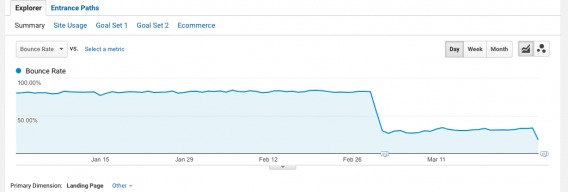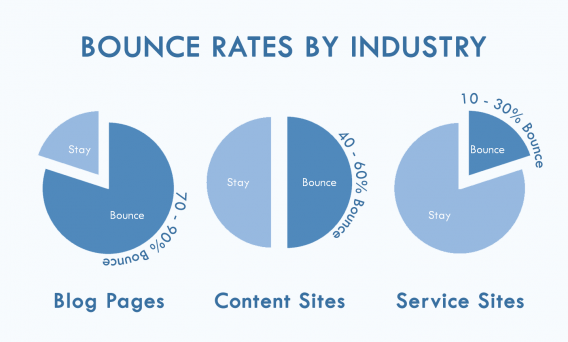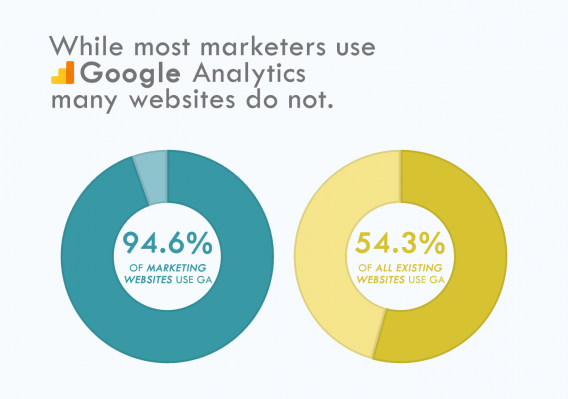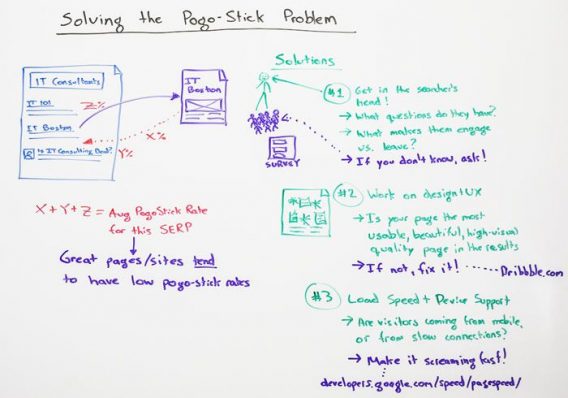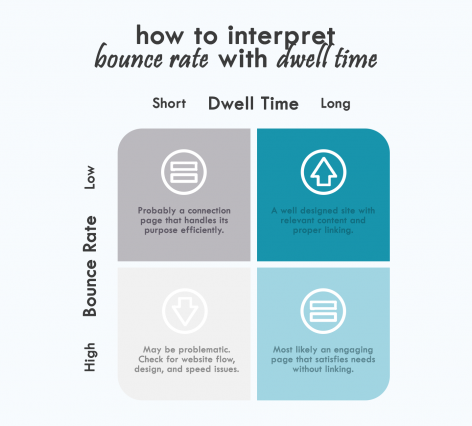SEO experts have debated the relevance of Google Analytics bounce rate to search engine ranking for years.
Yet, several misconceptions still surround the topic. The result is many website owners optimizing for lower bounce rates in hopes of improving their ranking, while lower bounce rates don’t simply translate into higher rankings.
A well-documented conversation between Rand Fishkin, Founder of Moz, and Andrey Lipattsev, Google’s search quality senior strategist, illustrates this point perfectly. It turns out, when Rand ran tested intentionally increasing the bounce rate of various pages over the course of a few days, the results were inconclusive. In fact, in an almost perfectly even split, half of the rankings on the search engine results page (SERP) did change while half of the rankings did not.
Furthermore, Matt Cutts, Google’s former head of Webspam, has denied Google’s use of bounce rates (and other Google Analytics metrics) in ranking algorithms.
The answer seems clear enough – bounce rates don’t affect SERP. Except, if that were truly the case, how do we explain Backlinko’s conclusion that low bounce rates are associated with higher rankings? Answering that question requires understanding three issues:
- What does bounce rate measure?
- Why doesn’t Google use bounce rate as a metric?
- How does bounce rate relate to other SEO factors?
Table of contents
What is bounce rate?
Bounce rate is the percentage of single-engagement visits to your site. That is the number of visitors who come to your page and leave without viewing any other page on your website or engaging with your page in any meaningful way (more on that in a previous chapter).
Marketers interpret this measurement to determine whether the webpage provided what the user was looking for.
Bounce rate is not a measurement of how long a user spends on your page. Much of the confusion arises from this distinction. You can have a great, engaging page AND a high bounce rate because bounce rate does not measure time spent on site.
This has two implications:
First, bounce rate is not necessarily bad.
While bounce rate might be explained by ineffective content and/or low accessibility, it can also be the result of mismatch between keywords and content or even purpose of page.
For example, a high bounce rate on a landing page or product launch page is basically inevitable (especially with the trend in one-page websites). You might also desire a high bounce rate for informational pages where users can find what they’re looking for and then move on. A good example of this is Wikipedia.
Therefore, optimizing for bounce rate does not necessarily mean you are improving the quality of your website or helping your website become more useful for your visitors.
Second, overemphasis on bounce rate could decrease the usability of your site.
Imagine turning every page you have into two pages and linking them together to forcibly decrease the bounce rate of your site. From the analytics end of things, you have improved a KPI. From the user experience end of things, you’ve turned a simple, accurate site into a mess. The roadmap of your website and your user funnel should be purposeful in design rather than bounce rate focused.
Why doesn’t Google use bounce rate as a metric?
Based on what bounce rate measures, it is easy to see why Google doesn’t use the bounce rate you see on Google Analytics as a ranking factor on SERP. We can break it down into four main reasons.
1. Bounce rate is not a reliable measurement of quality.
As discussed before, bounce rate cannot accurately determine user engagement because it does not factor in time spent on page. At the same time, bounce rate varies widely across industries. According to Clicktale, blogs tend to have bounce rates of 70-90%, content sites about 40-60%, and service sites only 10-30%.
It does not make sense for Google to punish certain types of websites based on their Google Analytics’ bounce rate if the purpose of the page is not to lead the user through the rest of the website.
One comment left by DatingSolutions on an eCreative IM post is indicative of this problem.
For them, their high bounce rate is explained by the display of many of their images in Google search results. When people search for their images and click on them, the image is displayed and counts as a hit for the website as well as a bounce when people close the image after viewing it.
Deciphering between the two becomes impossible if the same keywords proc for both the website and the image.
2. Google lacks motivation to access Analytics data.
While we see Google Analytics data as integral to any sort of testing or analysis, Google isn’t likely to see things the same way.
People who believe Google has reason to stalk Google Analytics data cite one of two reasons, each of which can be deconstructed (though do note, a certain degree of conjecture has been employed on both sides since Google’s actual algorithm is proprietary).
Argument #1: Google gives preferential treatment to Google product users.
The thesis is simple. Google should (in theory) want to reward users supporting its business, whether it be through Google AdSense, AdWords, or Analytics.
The problem with this theory is that it is completely conjecture.
More importantly, Google could easily run into a legal issue if it were to implement this system. By preferentially treating users of its software and incentivizing even more use of its search functions, it creates a positive feedback loop that may bring up questions of monopoly.
Google would be prudent to avoid vague waters.
Argument #2: Google Analytics reveals valuable information to Google.
If installing Google Analytics gave Google extra information about your website, concerns about bounce rate factoring into SERP make sense. However, Google is already harvesting all this information on its own. It did start, after all, as a WebCrawler. Stated plainly, Google already has access to everything it needs – who do you think provides all the data in Google Analytics anyways?
More importantly, Matt Cutts has stated, though albeit indirectly, Webspam’s avoidance of Google Analytics data. To quote: “You can use Google Analytics, you cannot use Google Analytics, it won’t affect your ranking within Google search results.”
Therefore, what you see on Google Analytics is likely of no interest to Google search algorithms.
3. Google Analytics can be easily manipulated.
The amount of posts published on how to detect and filter out bot behavior in Google Analytics should be a powerful indicator on its own of Google Analytics’ inherently unreliable nature. If Google Analytics isn’t powerful enough to automatically filter out manipulative behavior, there is no reason for Google to employ this “flawed” data in its ranking system.
4. Many websites do NOT use Google Analytics.
Because 94.6% of marketing websites use Google Analytics, it is difficult for us to conceptualize any website not using Google Analytics. But the fact is, by W3Techs’ estimates, only about 54.3% of all websites use Google Analytics.
Not only are there sites that don’t use any type of analytics tools, of the sites that do use analytics tools, not all use Google Analytics. Sites also use tools such as Clicky, New Relic, Amplitude, Heap, Yandex Metrica, and WordPress Jetpack. Therefore, Google Analytics’ bounce rate cannot be used as a ranking factor.
However, up to this point, we’ve been discussing bounce rate in terms of the percentage we see on Google Analytics. It should be intuitive to anyone that Google does not need to rely on Google Analytics to source data about the traffic and content of websites. Instead, Google employs its own tools to determine your actual website bounce rate: the pogo-sticking algorithm.
The pogo-sticking algorithm is Google’s tool for tracking user pogo-sticking. When a user clicks a link, realizes it is not what they’re looking for and returns to the search results page to click on another link, they are pogo-sticking – bouncing around from page to results to page to results and so on.
Hold up, pogo-sticking sounds ridiculously similar to bounce rate. Indeed, their similarity is often a point of confusion. However, whereas a high bounce rate means:
- Webpage is attracting the right audience and satisfying their needs on the landing page; or
- Webpage is attracting wrong audience and causing them to leave unsatisfied
Pogo-sticking is only caused by the latter. This means whereas high bounce rates can sometimes be good, pogo-sticking is always considered bad.
According to Google’s “search pogosticking benchmarks” patent, Google tracks the number of times search results are selected before a user settles on a particular result as well as how many other results are clicked after a particular result.
If users click on many other links after visiting your webpage AND you have a high bounce rate, Google’s algorithm concludes you are causing users to pogo-stick. Your ranking is then negatively affected as you are leaving your users unsatisfied due to ranking for irrelevant keyboards, using confusing webpage design, or providing inadequate amounts of content.
Google does not quantify the amount of pogo-sticking your webpage causes through bounce rate, but rather through the number of long clicks and short clicks your website generates.
A long click occurs when a user clicks on a result and stays on that page for a long time. They don’t return to the results page. A short click, on the other hand, occurs when a user clicks on a link and quickly returns to the results page. Long clicks are the best sign of user happiness and what Google optimizes for.
For SEO, the implications are clear, ranking requires generating long clicks and keeping your long to short click ratio high rather than dwelling on bounce rate.
However, knowing why Google doesn’t use Google Analytics’ bounce rate brings us to a rather surprising conclusion: bounce rate still matters.
How does bounce rate relate to other SEO factors?
This question is the one most that SEO articles won’t talk about, but it’s probably the most important one.
At the end of the day, what’s important isn’t whether Google is tracking bounce rate through Google Analytics and changing your webpage ranking based on it. After all, direct implications are easy to track. What matters is how bounce rate indirectly affects the SEO factors Google does care about.
To start, let’s return to the pogo-sticking discussion. By this point, it should be clear pogo-sticking is something we cannot directly track through analytics tools. Google’s black-box algorithm isn’t exactly easy to analyze. However, we can work around this knowledge hole by combining two factors we do know: bounce rate and dwell time.
While you cannot analyze search intent with these two variables, you can generate a pretty good estimate of how much of your organic traffic classifies as long clicks.
Simply, if your webpage has a high bounce rate, but users on your page also have a high dwell time, your webpage likely has a good long click percentage even though your bounce rate would typically be considered damaging. By taking dwell time into account, you can avoid unnecessarily optimizing for bounce rate.
Second, high bounce rate is often a symptom of weakness in other SEO factors. Here are just a few SEO problems you might want to check for when your bounce rate is abnormally high:
- Slow loading speed
- Low-quality webpage design
- Mismatch between content and keywords
- Poor mobile optimization
These problems are treatable and often addressed when SEO experts “fix” bounce rate.
The problem occurs when the focus is on bounce rate (the symptom) rather than the underlying issue. Therefore, it makes sense why “fixing” your webpage bounce rate often helps your SERP ranking but can sometimes affect nothing.
Conclusion: So what?
The key takeaway is this: while bounce rate doesn’t directly affect your page ranking, it bounce rate is still something you should understand and be able to improve upon.
High bounce rates (when calculated correctly) are often symptoms of deeper problems like user experience issues or poor targeting. These are the things you should worry about. If you work on the deeper problems like usability and customer targeting, SEO problems tend to improve as well.
Read Next Lesson or Download guide as PDF
-
Bounce Rate in Google Analytics
Since Google Analytics is far and away the most popular web analytics tool, it pays to know exactly how bounce rate is calculated in Google Analytics. -
Bounce Rate Benchmarks: What’s a Good Bounce Rate, Anyway?
"What's a good bounce rate?"...common question, not a super clearcut answer. This piece will explore bounce rate benchmarks and give you a good baseline understanding of where you may stand. -
Email Bounce Rate: How to Manage Soft & Hard Email Bounces for Better Performance
While most people think of bounce rates in terms of website analytics, email bounce rates are a thing, too. -
The Top 4 Ways to Lower Bounce Rate
Now for the meat of the guide: how do we lower bounce rates? -
The SEO Impact of Bounce Rate (What You Need to Know)
Does bounce rate affect SEO? Some say yes, some say no, but this article spits the truth of the matter. -
Bounce Rate vs. Exit Rate: What’s the Difference?
Unfortunately, the two metrics are often misunderstood and used interchangeably, when it is their subtle differences that make them useful metrics. -
Conclusion
Summary and wrap up.
